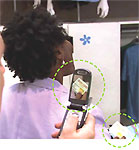 PREVENTING IDENTITY THEFT: a GUIDE for CONSUMERS
PREVENTING IDENTITY THEFT: a GUIDE for CONSUMERS PREVENTING IDENTITY THEFT: a GUIDE for CONSUMERS
PREVENTING IDENTITY THEFT: a GUIDE for CONSUMERS
NATIONAL CRIME PREVENTION COUNCIL
Bureau of Justice Assistance
Office of Justice Programs - U.S. Department of Justice
National Crime Prevention Council
PDF Version
The National Crime Prevention Council (NCPC) is a private, nonprofit tax-exempt [501(c)(3)] organization whose primary mission is to enable people to create safer and more caring communities by addressing the causes of crime and violence and reducing the opportunities for crime to occur. NCPC publishes books, kits of camera-ready program materials, posters, and informational and policy reports on a variety of crime prevention and community-building subjects. NCPC offers training, technical assistance, and a national focus for crime prevention: it acts as secretariat for the Crime Prevention Coalition of America, more than 360 national, federal, state, and local organizations committed to preventing crime. It hosts a number of websites that offer prevention tips to individuals, describe prevention practices for community building, and help anchor prevention policy into laws and budgets. It operates demonstration programs in schools, neighborhoods, and entire jurisdictions and takes a major leadership role in youth crime prevention and youth service; it also administers the Center for Faith and Service. NCPC manages the McGruff® "Take A Bite Out Of Crime®" public service advertising campaign. NCPC is funded through a variety of government agencies, corporate and private foundations, and donations from private individuals.
This publication was made possible through Cooperative Funding Agreement No. 2002-DD-BX-K004 from the Bureau of Justice Assistance, Office of Justice Programs, U.S. Department of Justice. Opinions are those of NCPC or cited sources and do not necessarily reflect U.S. Department of Justice policy or positions. The Bureau of Justice Assistance is a component of the Office of Justice Programs, which also includes the Bureau of Justice Statistics, the National Institute of Justice, the Office of Juvenile Justice and Delinquency Prevention, and the Office for Victims of Crime.
INTRODUCTION
Few crimes have made people more anxious more quickly as the sudden onslaught of identity theft.
It’s in the newspapers every day and on the news every night. People are worried that someone’s going to run up charges on their credit cards or fleece their bank accounts while their backs are turned. And there’s some reason to worry: All a thief has to do is steal something as basic as a Social Security number to become a real public enemy. And while these crimes are relatively easy to commit, investigating and prosecuting them are complex and time-consuming matters. So it’s up to all of us to be identity-smart and make sure we keep this crime from spreading. It’s a battle we can win. Follow the tips in this booklet, be careful, and we’ll keep a big step ahead of identity thieves. It’s up to all of us to prevent identity theft.
— Al Lenhardt, president and CEO, National Crime Prevention Council
WHAT’S IDENTITY THEFT?
The U.S. Department of Justice defines identity theft this way:
“Identity theft is a crime. Identity theft and identity fraud are terms used
to refer to all types of crime in which someone wrongfully obtains and
uses another person’s personal data in some way that involves fraud or
deception, typically for economic gain.”
 FACTS AND FIGURES
FACTS AND FIGURES
These statistics about identity theft
are worth knowing.
According to the U.S. Postal Service, there were almost ten million incidents of identity theft in the United States in 2004, a huge figure dwarfed only by its cost to consumers—$5 billion. And limiting your use of your personal computer may not help much: a study released in January 2005 by the Better Business Bureau and Javelin Strategy and Research reported that most identity thefts take place offline, not online—just the opposite of what many folks might think. In fact, the study found, the theft of online information accounted for only 11.6 percent of identity fraud cases.
Half of all identity thefts are committed by someone the victim knows. |
Nonetheless, a rash of headline-grabbing scandals involving thefts of millions of personal records, together with the advent of phishing and pharming thefts, may well change that figure dramatically in 2005. One other troubling finding: the study found that half of all identity thefts are committed by someone the victim knows.
 In spring 2003, the Federal Trade
Commission (FTC)—the federal agency
responsible for tracking identity theft—conducted
a major study of this crime. Among
its findings:
In spring 2003, the Federal Trade
Commission (FTC)—the federal agency
responsible for tracking identity theft—conducted
a major study of this crime. Among
its findings:
In another study, covering 2004, the FTC reported that of 635,000 complaints registered with the agency, 61 percent involved fraud and 39 percent were identity theft complaints. This study also revealed the following:
The FTC also presented some figures about identity theft committed over the Internet. Of 205,568 Internet-related complaints, 90 percent of the victims reported they had suffered a financial loss. The average loss was $1,440.
According to the FTC, the highest reports of identity theft occurred in Phoenix-Mesa- Scottsdale, AZ; Riverside-San Bernardino- Ontario, CA; and Las Vegas-Paradise, NV. While sunny Phoenix and Las Vegas are retirement meccas, the FTC found that of all those who reported being victimized in the United States, only 9 percent were 60 and over while the largest number, 29 percent, were in the 18 to 29 age group.
A CROOK’S BAG OF TRICKS
Watch Out for Thefts Like These
Here’s a sample of the way identity thieves commit their crimes.
Identity thieves may steal the Social Security numbers and identities of children who are especially vulnerable because they don’t already have credit histories and it may be many years before the theft is discovered. |
Financial Crimes
Identity thieves also include crimes like these in their repertoire of dirty tricks.
When Money’s Not the Object
Sometimes, the thieves aren’t after money. They may use your identity to commit crimes like these:
HOW TO PREVENT IDENTITY THEFT
Follow these tips to help ensure that you don’t become a victim.
 Mail Matters
Mail Matters
E-Commerce
 Personal Finance
Personal Finance
Banking
Strictly Confidential
Top Security
REPAIRING THE DAMAGE
If you’re the victim of identity theft, you’ve got your work cut out for you. Not only will you have to cope with the emotional toll of being a victim of crime, but it will take all the effort you can muster to repair the damage done to your good name and credit. Here’s where to start.
Contact the Credit Reporting Agencies
As soon as you know your identity has been stolen, call one of the three major credit reporting agencies. The law requires the agency you call to contact the other two. The agencies will flag your account; this means that any business that wants to view your credit report to give you credit will first have to verify your identity. Upon request, the three agencies will then send you two free reports over the next 12 months. (Beginning in September 2005, the Fair and Accurate Credit Transactions Act requires the three major credit reporting agencies to provide you with a free report once a year regardless of whether you’ve been a victim of fraud, but you must request them from www.annualcreditreport.com or 877-322-8228.) The three major credit reporting agencies and their toll-free numbers for reporting fraud are listed below.
| Equifax 800-525-6285 |
Experian 888-397-3742 |
TransUnion 800-680-7289 |
Work With Your Creditors
If you discover unauthorized charges on your credit report or any billing statement, contact the fraud department of the creditors you believe have been robbed in your name. You have 60 days from the date you normally receive your bill to notify them. If you notify your creditors within this time frame, your loss for unauthorized charges will be limited to $50.
CATCHING THE CRIMINALS
Check Your Bank Accounts
If someone is illegally using your bank account, close the account right away and ask your bank to notify its check verification service. The service will notify retailers not to honor checks written on this account. In most cases, the bank is responsible for any losses. To find out whether someone is passing bad checks in your name, call the Shared Check Authorization Network at 800-262-7771.
If you think someone has opened a new checking account in your name, you can ask for a free copy of your consumer report from Chex Systems (800-428-9623, Consumer Debit Resource), the consumer reporting service used by many banks. If your bank doesn’t use Chex Systems, ask for the name and number of the consumer reporting service it uses.
Call the Police
As soon as you can, contact your local police or sheriff’s department. The police should take your report and give you a copy, or at least the number of the report. You should also consider reporting the crime to your state law enforcement, since many states have recently toughened their laws against identity theft. You will need a police report to pursue your case with creditors who have been victimized in your name. You may also want to contact the office of your state attorney general for consumer fraud information. For a list of state attorneys general, go to www.naag.org.
Be sure to give the police copies of all the documents that support your claim. You may want to provide them with a notarized copy of the Federal Trade Commission’s ID Theft Affidavit, available from www.ftc.gov/bcp/edu/microsites/idtheft//.
Because an identity is frequently stolen in one place and used in another, you may also have to contact the police in the place where the crime took place. Your local law enforcement or the creditors affected can tell you if this is the case.
What’s the Law? The federal Identity Theft and Assumption
Deterrence Act of 1998 (18 U.S.C. Section
1028) makes it a federal crime when anyone |
 Other Numbers To Call
Other Numbers To Call
Tips for Reporting Identity Theft
|
THREE STEPS TO PREVENTION
This booklet has talked about what you can do to protect yourself against identity theft. But there’s also strength in numbers: What else can you and your family, friends, and neighbors do to fight this type of crime? Here are some suggestions.
1. Adopt the measures suggested in this booklet. Set half an hour aside for three days to make the phone calls and take the other steps suggested in this booklet (such as stowing your important papers in a secure place at home).
2. Share this booklet with your family and friends and see if they can come up with other ways to prevent identity theft.
3. Organize a meeting in your school, community center, senior citizen’s center, church, or synagogue and invite a police officer to come and tell people about the identity theft problem and what they can do to prevent the crime.
RESOURCES
The Federal Trade Commission,
www.ftc.gov/bcp/edu/microsites/idtheft//
The Office for Victims of Crime at the U.S.
Department of Justice,
ovc.ncjrs.org/findvictimservices/
The U.S. Department of Justice,
www.usdoj.gov/criminal/fraud/idtheft.html
The National Criminal Justice Referral Service,
www.ncjrs.org/spotlight/identity_theft/facts.html
The Identity Theft Resource Center,
www.idtheftcenter.org
The National Crime Prevention Council’s website.
Go to www.ncpc.org, click on “What We Offer,”
go to “What You Can Do,” and click on “Protect
Yourself Against Identity Theft.”
Copyright © 2005 National Crime Prevention Council
All rights reserved.
Printed in the United States of America July 2005
|
|